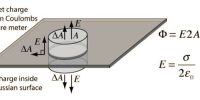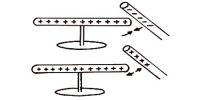Biot – Savart law expressed in an alternative way is called Ampere’s circuital law.
The magnetic induction due to an infinitely long straight current carrying conductor is
B = μ0 I / 2πα
B (2πα) = μ0I
B (2πα) is the product of the magnetic field and the circumference of the circle of radius ‘a’ on which the magnetic field is constant. If L is the perimeter of the closed curve and Io is the net current enclosed by the closed curve, then the above equation may be expressed as,
BL = μ0 I0 … (1)
In a more generalized way, Ampere’s circuital law is written as
∫ B.dl = μ0 I0 … (2)
The line integral does not depend on the shape of the path or the position of the wire within the magnetic field. If the current in the wire is in the opposite direction, the integral would have the opposite sign.
If the closed path does not encircle the wire (if a wire lies outside the path), the line integral of the field of that wire is zero. Although derived for the case of a number of long straight parallel conductors, the law is true for conductors and paths of any shape. Ampere’s circuital law is hence defined using equation (1) as follows:
The line integral ∫ B.dl for a closed curve is equal to μ0 times the net current I0 through the area bounded by the curve.












